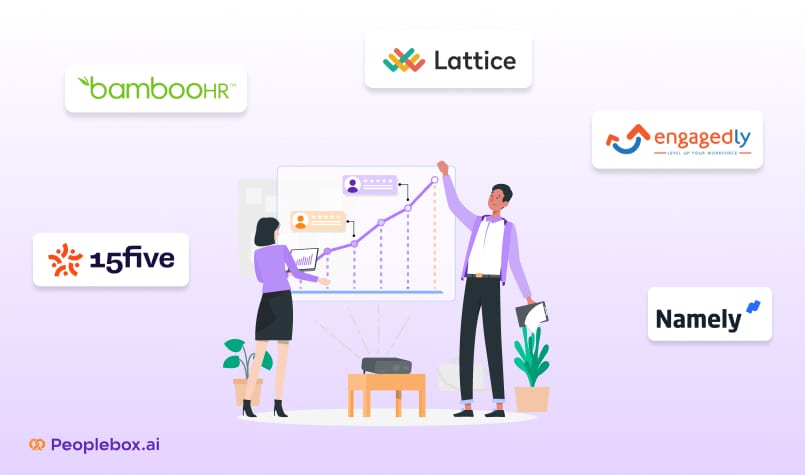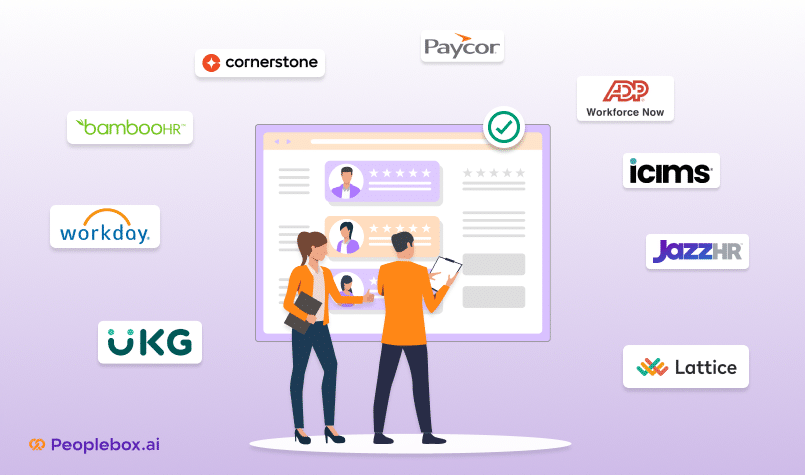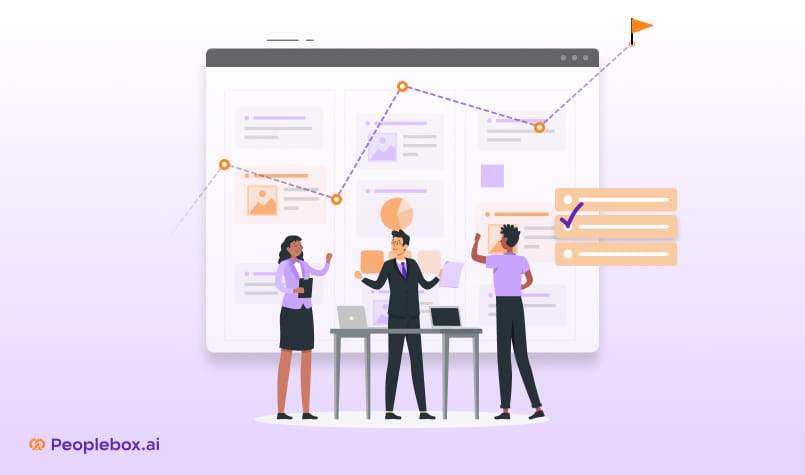Few years ago, IBM began a substantial redesign of its human resources procedures, combining artificial intelligence with internal technologies. This change was not just intended to reduce expenses but also to make HR processes faster, smarter, and more intuitive. For example, their AI-powered virtual assistant now handles hundreds of staff inquiries at once, ranging from payroll questions to time-off requests, all without breaking a sweat.
In fact, studies suggest that automation can reduce administrative expenses for HR departments by 30% and businesses by 49%.
HR automation, when rightly employed, is an effective alternative that is affordable and simple to implement. In this blog, we’ll look at
- What is HR automation?
- Why do you need Human Resources automation for your business?
- Key HR tasks you can automate with examples
- How do you choose the right HR automation platform?
Let’s get started!
What is HR Automation?
HR automation is the use of automated software solutions to handle certain HR tasks without human effort. It’s about streamlining and optimizing HR workflows to make them quicker, more accurate, and consistent. At its core, Human Resources automation aims to create better experiences for employees and job candidates.
With HR automation tools in place, you’ll see:
- Faster response times to queries and requests
- More accurate data management and reporting
- Better candidate experiences through automated applicant tracking systems (ATS)
- Easier onboarding processes with digital workflows
- More efficient employee self-service portals for routine tasks
Why does automation make sense for HR teams? When HR professionals spend less time on repetitive, manual, or administrative tasks, they can dedicate more face-to-face time to people.
Benefits of HR Automation for Your Business
About two-thirds of HR managers (that’s 66%) see it as a golden opportunity to shift their focus from day-to-day tasks to the bigger picture of supporting long-term business goals.
You’ve probably heard about how AI and automation can be used in HR. But let’s break it down and look at some standout advantages.
1. Increased departmental efficiency and productivity:
HR automation software reduces time-intensive procedures like resume screening, timesheet updates, and onboarding/offboarding, allowing HR staff to focus on strategy. The increased productivity also has a domino effect in other areas, allowing for the automated provision of new employees with the appropriate resources and access.
2. Assured compliance:
HR automation ensures your company always adheres to employment laws and tax rules, no matter where you’re hiring. It helps create contracts that meet local standards, manage employee benefits accurately, handle paperwork efficiently, and keep all records well-organized. This reduces the risk of legal issues from common errors like incorrect worker classification or data privacy breaches.
3. Data-driven insights:
HR automation facilitates data gathering and processing, allowing HR personnel to access real-time information rather than depend on assumptions easily. When managing employee performance, this data is invaluable in identifying patterns and areas for improvement. Automated reporting solutions also make it simple to communicate these insights with managers and executives to aid in well-informed decision-making.
4. Reduced HR costs:
HR automation slashes labor costs by reducing manual tasks. It enables nearly complete automation of many HR activities, from hiring to exit interviews, allowing you to do more with fewer people. This efficiency cuts down on mistakes and helps avoid compliance penalties, keeping your company’s reputation secure.
5. Ongoing performance assessment and management:
Continuous performance management replaces conventional annual performance assessments, and HR automation is helping with this transition. Using automation tools, HR teams will be supported in promoting talent development and continuous performance improvement through real-time feedback, goal monitoring, and agile performance discussions.
Common HR Automation Challenges
While automating HR operations has numerous advantages, there are also certain limitations and challenges to overcome. Here are a few challenges you might face in the course of HR automation implementation.
1. Financial constraints and ROI justification –
Implementing HR automation requires substantial investment. HR leaders must build a compelling business case, demonstrating a clear Return on Investment (ROI) to secure budget approval. This often involves quantifying time savings, error reduction, and improved strategic capabilities.
2. Change management and user adoption –
Like any digital transformation initiative, HR automation can face resistance from employees accustomed to traditional processes. Overcoming this resistance requires a well-planned change management strategy, including clear communication of benefits, comprehensive training programs, and ongoing support.
3. Scalability and flexibility concerns –
As organizations grow and evolve, their HR needs change. It’s essential to choose automation solutions that can scale with the business and adapt to new requirements. This might involve selecting cloud-based SaaS solutions over on-premises software for greater flexibility.
4. Data quality and migration issues –
Automating HR processes often requires migrating data from legacy systems. This can uncover data quality issues and inconsistencies that need to be addressed to ensure the new system functions correctly.
Key HR Processes You Should Automate (Real-Life Examples)
According to SHRM (Society for Human Resource Management), over (25%) of companies now leverage automation or artificial intelligence (AI) in their HR operations. The key HR processes automated by global industry leaders include:
1. Recruitment
Generative AI is creating a buzz in the HR world, especially when it comes to recruitment. With global hiring now the norm, recruiters are dealing with more applications than ever before. Here’s how automation can transform your recruitment process:
- Interview scheduling: Such tools can manage to find suitable interview times, reducing administrative burden.
- Skill assessments: Automated tests can evaluate candidates’ skills objectively and consistently.
- Data analysis: AI can spot patterns in hiring data, helping to refine your recruitment strategy over time.
Automation also helps in reducing bias in the initial stages of recruitment, as it focuses on qualifications rather than personal characteristics. This can lead to a more diverse candidate pool.
2. Employee Onboarding
New employee onboarding includes filing and receiving signed paperwork, providing software access, requesting devices, completing tax paperwork, and configuring tools. It also includes making sure the new recruits are familiar with their team and have all the tools they need to start their jobs independently. You can easily automate the employee onboarding process through:
- Electronic forms: Electronic forms allow all necessary paperwork to be completed and signed digitally.
- Pre-boarding: These tools provide access to training materials, company policies, and other essential resources to help them feel prepared and informed as they step into their new role.
- Automated training: Automated training platforms offer new employees a variety of learning tools, such as e-learning modules, instructional videos, and quizzes.
Automating HR processes with respect to these onboarding aspects means you’re not just saving time and reducing errors. You’re creating a more engaging, consistent, and efficient experience for your new hires.
3. Time Tracking and Attendance
It takes a lot of back-and-forth contact to submit leave requests by email or Slack messaging with many parties (immediate boss, the HR team, and, in certain situations, top management).
Without real-time employee time off data, you risk overlooking vital information or spending too long to process approval, which can affect corporate operations and collaboration. You can save much time through the following automations.
- Shift scheduling: Automating shift scheduling considers employee availability, skills, and organizational needs to create optimized work schedules.
- Overtime calculations: To comply with labor laws and ensure accurate compensation, automation tools precisely calculate overtime hours based on established rules.
- Time and attendance reports: Time and attendance automation tools can generate detailed reports that illuminate employee attendance patterns, productivity, and labor costs.
4. Payroll Processing
With payroll automation, HR can save time and money by not having to manually calculate each employee’s salary, commissions, overtime compensation, deductions, and more. With this solution, you may speed up your payroll processing time, safeguard your payroll data from illegal access, and maintain records for as long as needed.
You can do this through the following.
- Self-service portals: These portals empower employees by giving them direct access to their pay stubs and tax forms, as well as the ability to update personal details or benefits elections online, reducing the administrative burden on HR.
- Time-off tracking: These tools enable employees to request and track their leave online. Managers can review and approve these requests digitally, ensuring compliance and simplifying leave management.
- Automated payroll processing: Automated tools streamline the complex task of calculating wages, including base pay, commissions, overtime, and deductions. They span the entire payroll process from initial data entry to paycheck generation.
5. Employee Performance Reviews
When businesses automate their performance review records, they have immediate access to the information they need to decide on pay hikes, bonuses, disciplinary actions, or even termination. With the help of HR tracking these performance data, management may make comments, prepare for reviews, and check progress toward goals.
Automating performance tracking saves time and effort, eliminates bias, allows for more precise decision-making, and gives managers and staff a solid benchmark to work from.
- Automated goal-setting tools: They allow you to set SMART objectives and track progress for each employee in real time.
- 360-degree feedback integration: Automated 360-degree review tools collect insights from peers, subordinates, and managers, providing a comprehensive view of an employee’s impact.
- Predictive analytics: Advanced systems use machine learning algorithms to predict future performance trends, identify risks, and suggest interventions.
Also, users say,
Peoplebox is a lifesaver during our first-week reviews, allowing everyone to track goal progress and understand the reasons behind our achievements or misses. The evolving review template, especially the new deep dive and impact summary sections, provides a comprehensive view of our team’s progress. The latest addition of the goals summary offers a quick snapshot in just a few seconds. – Vijay Pal S
6. Leave Management
It can be difficult to calculate and approve vacation days manually because it requires a lot of work, from checking leave balances and submitting leave requests to documenting leave for payroll.
And if it’s just one person’s job, there’s a lot of potential for mistakes. While this individual is away on vacation or unwell, emails often get unread, and challenges may arise.
An automated leave management procedure through HR automation does all these tasks effectively.
- Leave conflicts alert: They automatically detect overlapping leave requests and alert managers, helping to prevent scheduling conflicts.
- Automation of leave requests: Modern leave management software allows employees to submit leave requests digitally, which managers can review and approve directly within the system.
- Customize leave types: Many systems offer customizable options to tailor leave policies according to company needs and ensure compliance with local labor laws. This applies to various types of leave, such as vacation, sick, and parental leave.
7. Benefits Administration
Companies must manage benefits packages, including health insurance, retirement accounts, workers’ comp, etc. The issue is that employees typically have minimal to no knowledge of the benefits during their employment.
Whether an employee’s circumstances alter, HR automation software can monitor their condition and show them its benefits. Staff members can use it as a model for self-service.
- Health and wellness management: These tools automate health and wellness benefits. They help employees enroll in, manage, and understand health insurance plans and wellness programs.
- Flexible Spending Account (FSA) and Health Savings Account (HSA) management: These focus on managing accounts that employees use for medical expenses, childcare, and commuting costs.
- Retirement and pension management systems: These platforms automate the management of retirement plans, such as 401(k) plans, ensuring that employees can easily modify their investment choices and track their account growth.
8. Employee Data Management
Following up with employees from various departments, their managers, prospective internal transfers or promotions, changes to personal data, and other issues takes time and effort in expanding teams and large corporations.
You can gather and update employee data more easily and in compliance with regulations when you automate employee data management. The following tools can help.
Centralized Data System: An HRIS (Human Resource Information System) consolidates all employee data in one location. It eliminates the need for multiple databases and reduces data inconsistencies.
Org charts: Automated systems can generate real-time org charts, reflecting current company structure and reporting lines. This provides instant visibility into workforce organization.
Workflow Automation: You can set up automated processes for common HR tasks like onboarding, promotions, or departmental transfers. This ensures consistency and reduces manual workload.
“Peoplebox is perfect for organizational leaders to review goal progress, offering both an executive overview and detailed month-on-month insights. It’s an ideal tool for facilitating these important conversations. – Vijeth.R”
9. Compliance Reporting
Automating HR processes like compliance management is crucial, especially for companies with a global presence. It minimizes human errors that can lead to legal or financial issues.
Moreover, automation speeds up the hiring process, allowing businesses to quickly onboard top talent without the delays often caused by manual legal procedures. Check out the following tools for compliance automation.
- Automated surveys: Implementing automated pulse surveys allows you to gather sensitive information consistently and compliantly. It’s a more controlled approach than relying on informal conversations that might inadvertently cross lines.
- Regulatory updates: Some advanced systems can automatically update their processes when regulations change, helping you stay ahead of compliance requirements.
- Document management: Automating compliance documentation collection and storage is crucial, especially for global teams. It helps you stay up-to-date with employment laws across different jurisdictions and sends automatic reminders for missing documents.
10. Offboarding
An efficient employee offboarding program with the following tools ensures that nothing slips between the cracks. In some cases, it can even inspire those who have left their jobs to become brand advocates.
- Exit interview scheduling: Use scheduling software to automatically set up exit interviews, ensuring no departing employees are overlooked.
- Final paycheck processing: Implement systems that automatically calculate and process final paychecks, including any accrued vacation time or bonuses.
- Access revocation: This is crucial for security. Automated systems can revoke access to company systems and deactivate app accounts precisely on the employee’s last day.
Top 10 HR Automation Solutions to Streamline Your Workflows
Boosting employee performance and engagement in today’s fast-paced business environment depends on selecting the appropriate HR automation tools, which also help to lower human error and lighten the HR staff workload. To improve productivity and simplify your procedures, here are ten outstanding HR automation tools you should give thought:
Top HR Automation Solutions for Small Businesses
#10 BambooHR – Suitable for small to medium-sized organizations, it includes modules for hiring, onboarding, time tracking, and performance management.
#9 Zenefits – Provides a simple dashboard for handling health insurance, payroll, and PTO, tailored at smaller businesses.
Talent Acquisition and Management
#8 Lever – Prioritizes hiring process efficiency through powerful application tracking system features and candidate relationship management.
#7 Greenhouse – Focuses on recruitment process automation and candidate experience enhancement.
Payroll and Benefits Focused
#6 Gusto – The primary focus is on payroll, but it also manages benefits and HR for small businesses.
Comprehensive HR Management
#5 UKG Pro (UltiPro) – Offers comprehensive HR, payroll, and talent management with extensive customization capabilities.
#4 ADP Workforce Now – Recognized for reliable payroll services and a comprehensive suite of HR administration solutions.
#3 SAP SuccessFactors – A comprehensive suite that includes employee experience, core HR, payroll, and talent management.
#2 Workday – Complete corporate management for HR, finance, and planning.
Engagement and Performance Management
#1 PeopleBox – Specializes in providing performance tools, including continuous feedback, goal tracking, and people analytics.
Make The Most of Your HR Automation with Peoplebox
If you’re looking to supercharge your HR automation, Peoplebox is a tool you definitely want on your radar. It’s an all-in-one platform designed to boost employee engagement and performance management and drive faster business results.
Peoplebox streamlines your HR procedures by allowing you to provide ongoing feedback, schedule one-on-one meetings, and track performance in real time. This means no more onerous spreadsheets or manual tracking — you’ll have everything you need to keep your team motivated and aligned right at your fingertips.
Oh, and the impact? It’s huge! Using Peoplebox will result in a more engaged and productive workforce. Employees receive the feedback they require to grow, while managers gain insights to effectively direct their teams. Furthermore, with automated reminders and simple tools, your HR team can concentrate on more strategic responsibilities rather than being mired down in administrative labor.
In short, Peoplebox not only simplifies your HR processes but also fosters a culture of continuous improvement and engagement. It’s a win-win for everyone involved!







